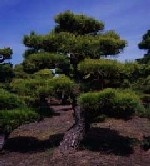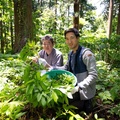It is mid-March in California’s Central Valley, and Richard Yamaguchi is very busy. One thousand black pine trees need to be trimmed and shaped; several must be carefully dug out and moved for landscapers in need of this familiar and iconic variety of Japanese conifer. Only two weeks remain before the trees come out of their seasonal dormancy, after which they cannot be trimmed or moved until next November, when all the remaining trees—some of which have taken 50 years to mature—will be dug up and sold to a major landscaping project in Texas.
Located in Sanger, California, the Yamaguchi Bonsai Nursery, established in 1956, reflects a half-century of knowledge, patience, and vision involving three generations of a family recovering from the hardships of World War II. In 1946 Hoshiko Yamaguchi and her husband Eisaku left the Tule Lake Segregation Center with son Richard and their three daughters. The family spent the next decade working as farm laborers before purchasing property. On it, Hoshiko planted a handful of black pine seeds that had been sent by her father, who operated a nursery in Hiroshima, Japan.
Starting out in wooden flats, seedlings were transplanted into the ground after one year. As they grew, they were moved to areas with more space and “trained” through a process involving the manipulation of their limbs with copper wire. With methodical care, these seeds developed into an impressive grove of trees that stand as tall as 12 feet and range in age from 35 to 51 years old.
Because black pines cannot be imported into North America as trees, this nursery may be the only place in the United States where a volume of mature trees can be obtained. As a result, the Yamaguchi Bonsai Nursery has transported trees for planting in landscapes as far away and as diverse as Washington, Arizona, and Connecticut. Trees from these few acres of land now grow on multimillion-dollar estates and in public botanic gardens.
Health reasons now keep Hoshiko Yamaguchi away from the trees, whose decades of intense care she calls “a time well spent.” Without her guidance, the family has decided to sell the remainder of the stock, and the nursery will soon close.
In the middle of the grove is a tree that Richard stops to admire. It grew from one of the first seeds planted on the property and is now about eight feet tall with a horizontal span of seven feet. “This is one tree that is going to be saved,” says Richard. “When I was little, I thought, ‘My gosh, who is going to buy all of these trees’ without realizing what they were going to look like in 50 years. It’s just amazing that she had the forethought to [create] this business. We’re keeping this tree in memory of our mother... a monument to her and all her hard work.”
* This article originally appeared in the Summer 2007 issue of the Japanese American National Museum Member Magazine.
© 2007 Japanese American National Museum







